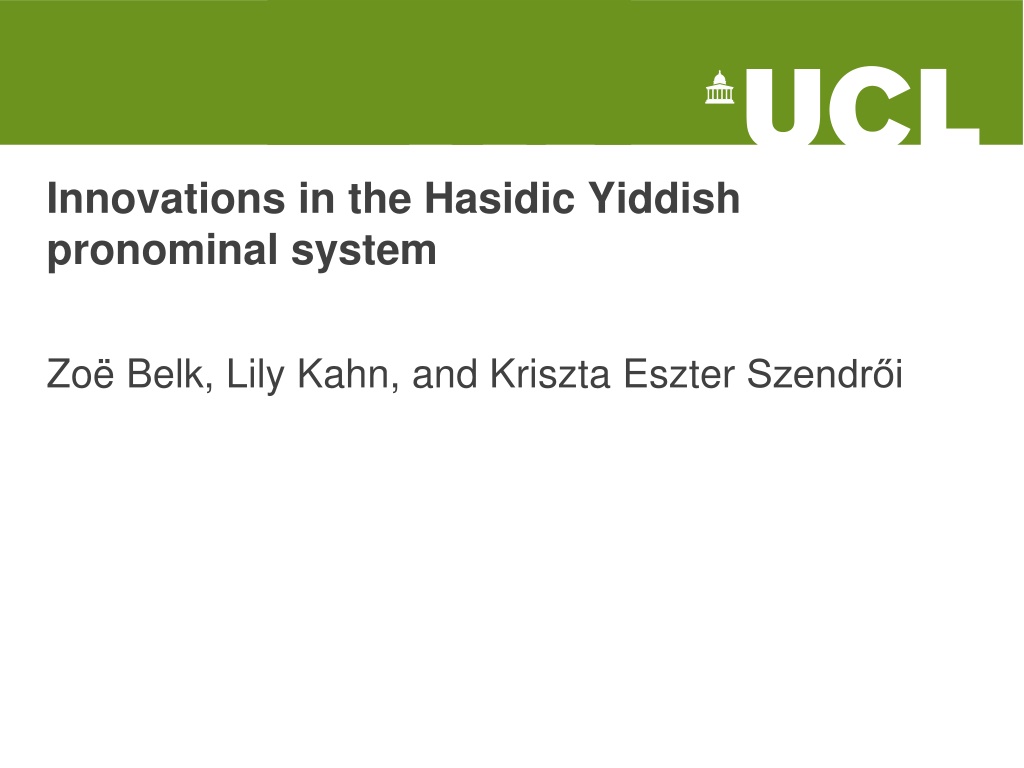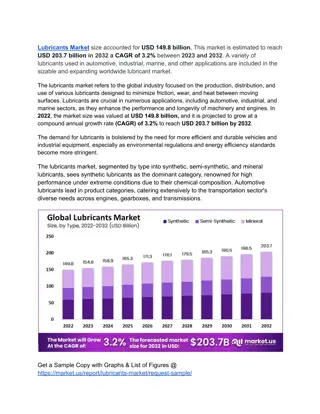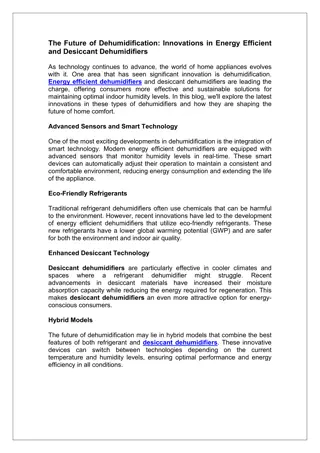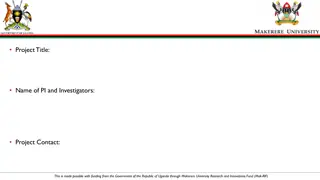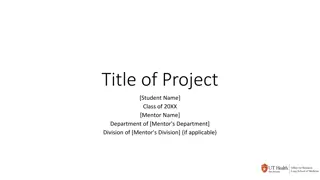Innovations in Hasidic Yiddish Pronominal System
Explore the evolution of pronouns in the Hasidic Yiddish language system, showcasing simplifications and changes over time. The research delves into the linguistic characteristics of Hasidic Yiddish speakers in Stamford Hill, London, highlighting the influences of various Hasidic groups and geographical origins. The comparison between pre-war and standard Yiddish pronouns reveals intricate shifts in plural and singular forms. Discover the complex interplay between tradition and modernity in the linguistic landscape of Hasidic Yiddish.
Download Presentation

Please find below an Image/Link to download the presentation.
The content on the website is provided AS IS for your information and personal use only. It may not be sold, licensed, or shared on other websites without obtaining consent from the author. Download presentation by click this link. If you encounter any issues during the download, it is possible that the publisher has removed the file from their server.
E N D
Presentation Transcript
Innovations in the Hasidic Yiddish pronominal system Zo Belk, Lily Kahn, and Kriszta Eszter Szendr i
Hasidic Yiddish in Stamford Hill, London Roughly 40-50,000 Yiddish-speaking Hasidic Jews (one of the largest in Europe) Community established post-World War II Different Hasidic groups, e.g. Satmar, Ger, Bobov, Slonim, Vizhnitz, Ruzhin Speakers heritage: mostly Polish and Hungarian Yiddish, but high degree of diversity in speaker backgrounds (non- Yiddish-speaking parents and grandparents, Sephardim, ba ale tshuva, converts, etc.) High degree of bilingualism (English, Hebrew) Rapid language changes including loss of noun gender and case
Elicited data background information o 8 native Yiddish speakers born and raised in Stamford Hill other Hasidic communities seem to have also lost case and gender, but we have no systematic data 2 male, 6 female age range: 20-50, mostly 20s Types of Hasidus: Satmar, Vizhnitz, Belz, Bobov, Slonim geographical origin: grandparents generation Hungary, Poland, Vienna, France, Israel, Iraq, UK, USA o o tasks other Hasidic communities seem to have also lost case and gender, but we have no systematic data online translation tasks judgment tasks unstructured interviews o
Pre-war and Standard Yiddish personal pronouns Plural Singular Dative Accusative Nominative Dative Accusative Nominative 1 undz mir mikh ikh mir 2 dir dikh du aykh * ir 2 (hon) aykh ir 3m im er 3f zey ir zi 3n es * In some pre-war dialects the forms and are used for the 2p.
Hasidic Yiddish personal pronouns Plural Accusative Singular Accusative Dative Nominative Dative Nominative 1 ) ( un(d)z mikh/mir \ ikh * un(d)z/mir ) ( \ 2 enk dikh/dir \ du 2 (hon) aykh aykh ir/aykh \ ir/aykh \ 3m ( im ) er 3f zey zi/ir/i \ \ zi 3n es mir is rare. can also be used (in the nominative). *
Simplification of case system 1sg \ > mir\mikh < ikh \ dir\dikh < du \ i\ir\zi < zi ) ( un(d)z enk < enk > aykh < aykh ~ ir 2sg > 3fs \ > 1pl > mir 2pl ~ 2pl (hon)
Personal pronouns: examples Simplification of case system 1sg acc 1sg dat ? kenstu mikh hern? can you hear me? zey hobn mikh gegebn de benkl they gave me the chair 2sg acc 2sg dat de lererin hot dikh lib the teacher likes you ikh geb dikh de bukh I give you the book 3fs acc 3fs dat ikh hob zi lib I like her ikh geb zi de bikhl I give her the book 1pl nom 1pl acc undz hob geshribn brivn eyne tsu de tsveyte we wrote letters to each other er git undz de shlisl he gives us the key 2pl nom (informal) 2pl acc/dat (informal) enk zoln im gebn de tish you should give him the table undz gebn es tsu enk we give it to you 2 nom (formal) 2 acc/dat (formal) ? ? hobn aykh undz lib? do you like us? ikh ken aykh fun ergets I know you from somewhere
Personal pronouns: interspeaker variation 1sg acc a b ? ? kenst mikh hern? can you hear me? kenstu mir hern? can you hear me? 1sg dat a b zay gebn mikh de benkl they give me the chair zay gebn mir de benkl they give me the chair 2sg dat a b ikh geb dikh de bukh I give you the book ikh geb dir de bukh I give you the book 3fs acc a b ) ( ikh hob zi zayer lib I like her very much ikh hob i(h)r zayer lib I like her very much 3fs dat a b ) ( ikh geb zi de bikh I give her the book ikh geb i(h)r de bukh I give her the book 1pl nom a b mir gebn enk de matone we give you (pl) the present un(d)z gebn enk de matone we give you (pl) the present
Personal pronouns: examples Intraspeaker variation 1sg dat a b du gebst mikh de bikhl you give me the book du gebst es tsu mir you give it to me 2sg acc a b ? de titsher hot dikh lib the teacher likes you ken ikh dir fun ergets? do I know you from somewhere? 3fs dat a b ) ( du gebst zi de bukh you give her the book er gebt es tsu i(h)r he gives it to her 1pl nom a b mir gebn enk de matone we give you the present undz gebn es tsu zey we give it to them
T/V distinction: examples Singular ? Informal . ikh bin azoy tsufridn dikh tsu zen. vilstu aropzitsn efsher? I m so happy to see you. Would you perhaps like to sit down? to friend, sibling, parent, often grandparent, sometimes parent-in-law, stranger Formal ? . ikh bin azoy tsufridn aykh tsu zen. vilt ir aropzitsn efsher? I m so happy to see you. Would you perhaps like to sit down? sometimes to grandparent or parent-in-law; to a rebbe Plural Informal . , tati mami voltn enk zikh gevolt aropzetsn, ikh bin freylekh enk tsu zen. Mum and dad, would you like to sit down? I m happy to see you. ? Formal . volt ir zikh gevolt aropzetsn do oyf a bakveme benkl? es iz mayn koved aykh tsu zen. Would you like to sit down here on a comfortable chair? It is my honour to see you.
Possessives Free-standing Plural Singular 1 un(d)zers\un(d)zere ,?un(d)zer ) ( \ ) ( ,? ) ( \ ,? mayns\mayne ,?mayn 2 enkers\enkere\enker \ \ \ ,? dayns\dayne ,?dayn 2 (hon) ayers\ayere ,?ayer \ ,? ayers\ayere ,?ayer \ ,? 3m \ ,? zayns\zayne ,?zayn \ \ zeyers\zeyere ,?zeyer 3f ires\ire ,?ir \ ,?
Free-standing possessives: examples deye feder iz mayns deye feder iz undzere this pen is ours 1sg 1pl deye feder iz mayn this pen is mine yene bukh iz undzers that book is ours iz deye tish dayne? is this table yours? iz deye pen enkere? is this pen yours? 2sg 2pl ? ? ikh hob gemeynt s iz enker(s) I thought it was yours ' ) de bukh iz dayns the book is yours ( de pen iz nisht zayne deye tish iz nisht zeyere 3ms 3pl deye tish iz nisht zayns the/this pen/table is not his de bukh iz nisht zeyers yene bikhl iz nisht zeyer this/the table/book is not theirs iz deye feder ire? Noun gender does not play a role in the choice of possessive. The same paradigm applies to plural nouns, though with a slight preference for the forms ending in - -e. 3fs ? iz de tish ires? is this/the pen/table hers? ?
Possessives Adnominal Plural Singular \ 1 un(d)zere\un(d)zer ) ( \ ) ( mayne\mayn 2 enkere\enker \ \ dayne\dayn 2 ayere\ayer \ ayere\ayer \ (hon) 3m \ zayne\zayn zeyere\zeyer \ 3f ire\ir \
Adnominal possessives: examples Singular noun Plural noun iz dos dayn feder? is this your pen? zenen deye dayne feders? are these your pens? 2sg ? ? yens iz dayne feder that s your pen iz dos ir(e) bukh? zenen deys ir(e) bikher? 3fs ? ? is thisher book? ? are these her books? ? deys iz undzer(e) blay/feder yens zenen undzer(e) 1pl this is our pencil/pen those are our tables iz deys enker(e) bukh? do zenen/iz dos enker(e) federn? 2pl ? ? is this your book? ? are these your pens? ? iz deys ayer(e) tish? zenen zey ayer bikhlekh? are they your books? 2hon ? ? is thisyour table? ?
Demonstratives Distal Proximal \ nom Free- standing yens yene yene deys\dos , \ obj deys\dos ,deye deye ,deh , Adnominal Adnominal demonstratives Singular Plural ? deye feder iz undzere this pen is ours zenen deh bikher ires? are these books hers? nom ? , kent ir gebn deh feder tsu mir? could you give that pen to me? zi hot genumen deye bikher nisht yene bikher I want this table, not that one acc
Free-standing demonstratives: examples Singular Plural ? yens iz mayne bikhl that is my book iz dos enkere federen are these your pens? nom ? ? iz dos enker bukh? is this your book? zenen deys ayer bikher? are these your books? ? mami hot geredt vegn yene Mum was talking about that one yens zenen undzer tishn those are our tables acc zi hot genumen deye nisht yene she took this table, not that one yens iz undzere tishn those are our tables
Interrogative where Stamford Hill Hasidic Yiddish Pre-war and Standard Yiddish vu ( (fun) vu ) vuhin ( (fun) vanen ) Examples ? vu iz de mesibe? where is the party? ? ? vu geystu where are you going? fun vu kumstu? where are you coming from?
Interrogative which Stamford Hill Hasidic Yiddish Pre-war and Standard Yiddish nom velkhes ,velkhe ,velkher , velkhn ,velkhe ,velkhn , velkhn ,velkher ,velkhn , , acc velkhe , dat ,
Interrogative which: examples Singular Plural nom f sg nom f pl ? ? velkhe feder iz dos? which pen is that? velkhe feders zenen zey? which pens are those? ? acc n sg nom m pl ? velkhe tishn zenen de beste which tables are the best? velkhe bukh hostu geleynt which book did you read? dat n sg dat m pl ? vegn velkhe bukh hostu geredt? which book did you talk about? ? mit velkhe blayen hostu geshribn which pen did you write with?
Interrogative who/whom Stamford Hill Hasidic Yiddish Pre-war and Standard Yiddish nom ver ver , vemen ,ver ) ... acc vemen ( , dat (mit) vemen ,vemen (mit) ( ) ( vemen (mit) ) Examples ? ? ver iz yens who is that? tsu vemen redstu who are you talking to? nom dat ? ? ver zestu? who do you see? vemen zestu? who do you see? acc acc
Reflexives and reciprocals: general tendencies Stamford Hill Hasidic Yiddish Pre-war and Standard Yiddish Reflexive zikh + zikh zikh Reciprocal eyne de tsveyte + zikh (etc.) eyner dem tsveytn (etc.) Note: Pre-war and Standard Yiddish reciprocal constructions can vary to some degree Stamford Hill Hasidic Yiddish use of and circumlocutions varies to some degree with reciprocals
Reflexives and reciprocals: examples a b du kenst zikh zen in shpigl you can see yourself in the mirror er ken zikh zen in de shpigl he can see himself in the mirror Reflexives c d undz kenen zikh zen in de shpigl we can see ourselves in the mirror enk zen zikh in de shpigl you can see yourselves in the mirror a b undz hobn zikh bagegnt we met each other mir redn eyne tsu de tsveyte we're talking to each other c d enk kenen zikh eynem dem andern you know each other Reciprocals me ken zikh zen eyne de tsveyte we can see each other e f undz nemen zikh arum we hug each other zey hobn zikh geshribn brivn eyne tsu de andere they wrote letters to each other
Conclusions Case in personal pronouns has been simplified (three cases have become two; two cases have become one) There is a large degree of inter- and intraspeaker variation in the personal pronouns A distinct singular/plural 2nd person honorific form has emerged Interrogative forms have been simplified ( where , which , and who ) Possessives and demonstratives exhibit a great degree of variation; no clear gender, case, or number distinctions; no clear difference between freestanding and adnominal; seemingly free variation Relatively clear distinction between reflexives and reciprocals The Stamford Hill Hasidic Yiddish pronominal system is comparatively streamlined and cohesive. Some new distinctions have emerged. The current system looks more like North and West Germanic languages such as Dutch.
! Thanks to Eli Benedict, Mendy Cahan, Shifra Hiley, Shmuel Hiley, and Izzy Posen and the Yung Yidish Library, Museum and Cultural Centre This research is funded by the Arts and Humanities Research Council.
